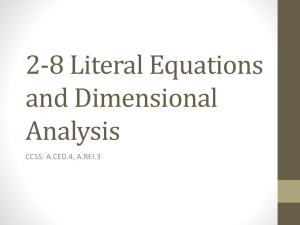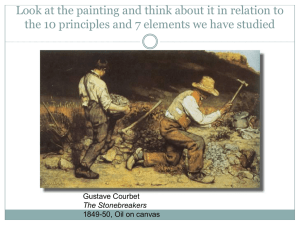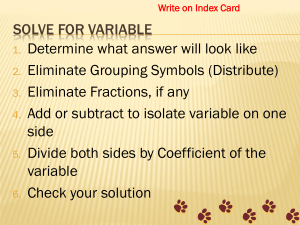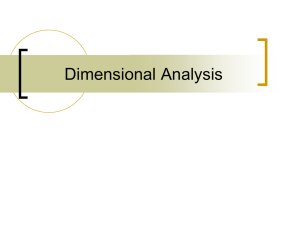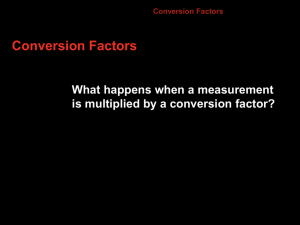Dimensional analysis
advertisement
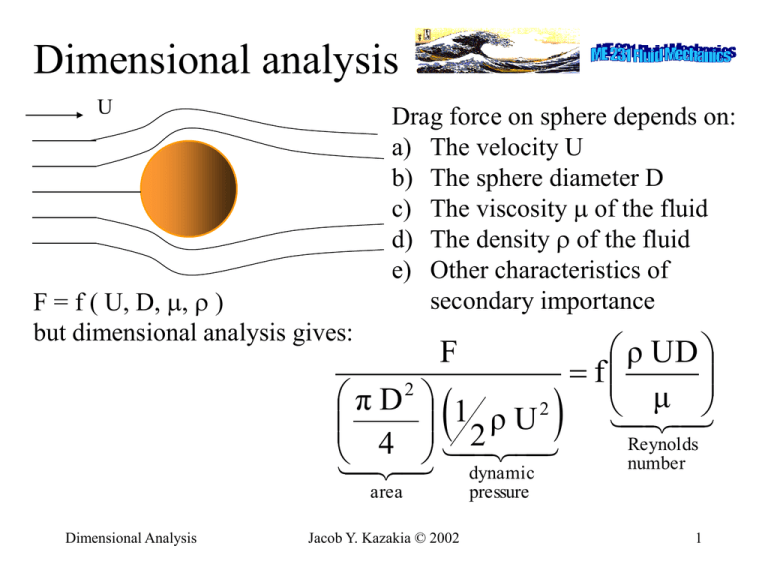
Dimensional analysis U F = f ( U, D, m, r ) but dimensional analysis gives: Drag force on sphere depends on: a) The velocity U b) The sphere diameter D c) The viscosity m of the fluid d) The density r of the fluid e) Other characteristics of secondary importance ρ UD f 2 μ πD 1 2 ρU 2 Reynolds 4 number dynamic F area Dimensional Analysis Jacob Y. Kazakia © 2002 pressure 1 Buckingham P Theorem Say we have : q1 f(q2 , q 3 , q 4 ,......qn 1 ) or g(q1 , q 2 , q 3 ,..........qn 1 , q n ) 0 The parameters can be grouped in n - m dimensionless groups Π1 , Π2 , Π3 ,.......Πn m Where m is the number of independent dimensions needed to express the dimensions of all q ’s. We then have a relationship: G ( P1, P2 , P3 ,..........Pn m ) 0 Dimensional Analysis Jacob Y. Kazakia © 2002 2 Ex1. Journal bearing The load-carrying capacity W of a journal bearing depends on: D a) The diameter D c b) The length l c) The clearance c d) The angular speed w l e) The viscosity m of the lubricant We must now go through the following 6 steps: 1) The number of parameters n = 6 ( including W ) 2) Select as primary dimensions: M, L, t ( mass, length, time) Dimensional Analysis Jacob Y. Kazakia © 2002 3 Ex1 – cont. 3) Write the dimensions of all parameters in terms of the primary ones D L lL All 3 primary dimensions are needed. c L r = 3 hence there must be w t –1 n – r = 6 – 3 = 3 dimensionless groups. m M L –1 t –1 W M L t -2 4) Select repeating parameters: D, w, m 5) Find the groups: D a w b m g l La tb M g Lg tg L = L 0 t 0 M 0 L: a g + 1 0 t: -bg 0 M: g 0 Dimensional Analysis a 1 b0 g0 Jacob Y. Kazakia © 2002 P1 = D-1 l 4 Ex1 – cont -1. We found P 1= l / D we similarly get P2=c/D third group: D a w b m g W La tb M g Lg tg M L t -2 = L 0 t 0 M 0 L: a g + 1 0 t : - b g 2 0 M : g +1 0 P3 = D-2 w1 m-1 W or P3 = W / (D2 w m ) 6) Write the relation among the P ‘s : Dimensional Analysis a 2 b 1 g 1 Jacob Y. Kazakia © 2002 W l c f , 2 D ωμ D D 5 Ex2. Extension of ex1 Suppose we had r in the list of the parameters in the previous example. We would then have an additional P ( nondimensional group) D a w b m g r La tb M g Lg tg M L-3 = L 0 t 0 M 0 L: a g 3 0 t: -bg 0 M : g +1 0 P4 = D2 w m-1 r Resulting in: Dimensional Analysis or a2 b1 g 1 P4 = D2 w r / m (Reynolds number) l c D 2w r W f , , 2 D ωμ m D D Jacob Y. Kazakia © 2002 6 Ex3. Belt in viscous fld. A continuous belt moving vertically through a bath of viscous liquid drags a layer of thickness h along with it. The volume flow rate Q of the liquid depends on m , r , g , h , and V where V is the belt speed. Predict the dependence of Q on the other variables. There are six parameters. The primary dimensions are : F, L, and t ( 3 of them) The repeating parameters will be: h, V, r [Q] = L3 / t [m] = F t / L2 [r] = F t2 / L4 [g] = L / t2 [h] = L [V] = L / t We must find 6 – 3 = 3 groups. h a V b r g Q La Lb tb F g t2g L4g L3 t1 = L 0 t 0 F 0 or by inspection we obtain: P1 = Q / ( V h2 ) Dimensional Analysis Jacob Y. Kazakia © 2002 7 Ex3. – cont. h a V b r g m La Lb tb F g t2g L4g F t L2 = L 0 t 0 F0 L: a + b 4g 2 0 t : - b + 2g +1 0 F : g +1 0 a 1 b 1 g 1 h a V b r g g by inspection we get: Result: Dimensional Analysis P2 = m / ( hVr ) Or equivalently P2 = hVr / m P3 = V2 / ( g h ) 2 Q hVρ V f( , ) 2 h V μ gh Jacob Y. Kazakia © 2002 Reynolds Froude number number 8 Ex4. Choice of repeating parameters A fluid of density r and viscosity m flows with speed V under pressure p. Determine a relation between the four parameters [V] = L / t [r] = M / L3 [p] = M / (L t2 ) [m] = M / ( L t ) V a r b p g m La ta M b L3b M g Lg t-2g M L1 t -1 = L 0 t 0 F0 L: a 3b g 1 0 t : - a 2g 1 0 M : b + g +1 0 Dimensional Analysis Jacob Y. Kazakia © 2002 But this system has no solution. See next slide 9 Ex4. –cont. a 3b g 1 0 - a 2g 1 0 b + g +1 0 1 3 1 1 1 3 1 1 1 0 0 1 2 1 1 1 0 3 3 2 0 1 1 1 1 3 1 1 0 1 1 1 0 0 0 1 Inconsistent system. No solution is possible But if we chose out repeated variables differently: V, r, m then everything is O.K. V a r b m g p La ta M b L3b M g Lg t-g M L1 t -2 = L 0 t 0 F0 Produces: a = -2 , b = -1, g = 0 and hence p / r V2 it is now easy to see why the previous choice did not work. Dimensional Analysis Jacob Y. Kazakia © 2002 10 Model flow Prototype torpedo: D = 533 mm , Length = 6.7 ft Speed in water: 28 m/sec Model: Scale 1/5 in wind tunnel Max wind speed : 110 m/sec Temperature : 20 0C Force on model: 618 N Find : a) required wind tunnel pressure for dynamically similar test b) Expected drag force on prototype We assume the parameters: F, V, D, r, m and we get by the earlier method: ρ V D F f 2 2 ρV D μ To attain dynamically similar model test we must have equal Reynolds numbers in both flow situations. Dimensional Analysis Jacob Y. Kazakia © 2002 11 Model flow – cont. Water at 20 0C mp = 1 x 10-3 Pa sec Air at 20 0C mM = 1.8 x 10–5 Pa sec VP DP μ M kg 28 5 0.018 kg ρM ρP 999 3 22.9 3 VM DM μ P m 110 1 1 m We must now find the pressure that will give this type of air density. IDEAL GAS LAW: kg N m p M ρ M RTM 22.9 3 287 293K 1.93MPa m kg K (about 20 atmospheres) The force: ρ P VP2 D2P 999 282 52 FP FM 618 N 43.7 kN 2 2 2 ρ M VM DM 22.9110 1 Dimensional Analysis Jacob Y. Kazakia © 2002 12
